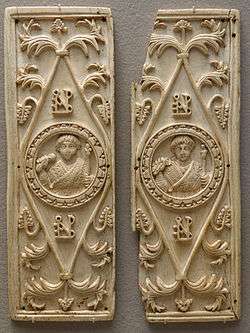Imago clipeata

Imago clipeata (Latin: "portrait on a round shield") is a term in art usually used in reference to the images of ancestors, famous people or deceased on round shields. In the Roman world they were used to depict the ancestral family tree in patrician houses of the Republic as described by Pliny, Historia Naturalis 35, 4-11.[1]
These shield portraits can be seen in architectural sculptural decorations, on sarcophagi and on standards of the Roman legions among many other types of representations in the Roman and Early Christian world. In Italian Baroque imagery, the medallion portraits supported by nymphs or genii came to signify an apotheosis. Here they are mostly referred to as tondo images.
External reference
Description and reproduction of Imago clipeata at the Forum of Augustus on the Athenian Acropolis
References
- ↑ Winkes, Rolf: Clipeata imago, Bonn 1969. Winkes, Rolf : Pliny's chapter on Roman funeral customs in the light of Clipeatae imagines, American Journal of Archaeology 83, 1979, 481-484.